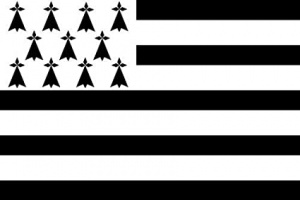Language/Breton/Vocabulary/Family
Breton Family Names History
Demat, Breton Learners! 😃
In today's lesson you will learn how to write and pronounce some useful words related to "the family" in the Breton language spoken in Brittany (France). You will also learn some information about the famous Breton Family Names.
Breton is a Celtic language spoken in Brittany, a region in northwestern France. It is closely related to Cornish and Welsh, and it has a rich cultural heritage that includes traditional music, dance, and festivals.
In this lesson, we will learn vocabulary related to family members in Breton language and also explore some cultural insights related to family and kinship in Breton culture.
Close Family Members in Breton
- Tad - father
- Mam - mother
- Breur - brother
- C'hoar - sister
- Mab - son
- Merc'h - daughter
- Meurzhin - uncle
- Tantez - aunt
- Kuzin - cousin
- Gwaz - husband
- Mamm-gozh - grandmother
- Tad-kozh - grandfather
More Family Vocabulary
- The family = ar familh
| Brezhoneg (Breton) | English |
|---|---|
| ar gourdad / gourdadoù | ancestor(s) |
| an dud-kozh | grandparents |
| an tad-kozh
ar vamm-gozh (mamm-gozh) |
grandfather
grandmother |
| ma zud | my parents |
| an tad, ma zad | father |
| tadig | dad |
| ar vamm (mamm), ma mamm | mother |
| mammig | mom |
| ar pried, ar gwaz
ar pried, ar wreg |
husband
wife, spouse |
| an den | man |
| ar wreg (gwreg) | woman |
| an aotrou
an itron |
mister
madam |
| ar gerent (kerent) | relatives |
| an eontr | uncle |
| ar voereb (moereb) | aunt |
| an niz
an nizez |
nephew
niece |
| ar c'henderv (kenderv)
ar geniterv (keniterv) |
cousin |
| ar gendirvi (kendirvi) | cousins |
| ar paotr / baotred | boy(s) |
| ar plac'h / plac'hed | girl(s) |
| ar mab / vibien (mibien) | son(s) |
| ar verc'h (merc'h) / merc'hed | daughter(s) |
| ar breur / vreudeur (breudeur) | brother(s) |
| ar c'hoar / c'hoarezed (c'hoarezed) | sister(s) |
| ar gevell / ar c'hevelloù (gevelloù) | twin(s) |
| ar bugel / ar vugale (bugale) | child / children |
| ar babig / ar babigoù | baby / babies |
| an dous | boyfriend
girlfriend |
| ar mignon / ar vignoned (mignoned)
ar vignonez (mignonez) / ar mignonezed |
friend(s) |
| an enebour / enebourien | enemy / enemies |
| ar gweladennour / weladennourien
ar weladennourez |
visitor(s) |
| ar c'houviad (kouviad) | guest |
| ar gouvidi (kouvidi),
an dud pedet |
guests |
| an amezeg / an amezeged, amezeien
an amezegez / an amezegezed |
neighbour |
| ar c'heneil (keneil) / ar c'heneiled (keneiled) | colleague(s) |
| an dud | people |
Cultural insights
In Breton culture, family and kinship are highly valued.
In Breton tradition, the eldest son inherits the family farm, and the youngest son usually enters the priesthood. Daughters are also important in the family, and they are expected to take care of their parents in their old age.
Breton people also have a strong sense of regional identity, and many families can trace their ancestry back several generations in the same area. The Breton language is an important part of this cultural heritage, and many families pass down their knowledge of the language and traditions to younger generations.
Family Names in Breton
A LONG STORY
Countless current Breton surnames and first names are personal names or men's names inherited from the past. It is further estimated that two out of three place names have a male name within them. There is, however, a big difference between a first name and a surname. The first results from the choice of the parents while the second is the fruit of a transmission from generation to generation.
Some anthroponyms are very old, others from more recent borrowings. Many refer to the warrior (Gwezhenneg/Guézennec), civil (Mevel) or religious (Manac'h) society of the early Breton Middle Ages. They are regularly found in old cartularies, such as that of Redon (8th-12th centuries). Other names correspond to qualifiers, to human qualities or to defects, physical or moral, to nicknames. Still others come from the names of professions or activities. Among the anthroponyms, there are some that are specific to Brittany, while others are common to many languages in different forms (Ex. Yann/Jean). Some nouns often have a feminine form (Prijant, feminine: ur Brijantez or ur Brijantenn), or plural (ar Foll, pl. ar Follijen). Some names are very common (ar Gall), others very rare and endangered.
A MISTREATED HERITAGE
Like toponymy, this anthroponymic heritage is abused. Most surnames were thus fixed in writing before the 17th century, following the rules of Latin and then of French (edict of Villers-Cotterêts, 1539). The spelled forms often present different variants for the same name, more or less altered. The case of the definite article at the head translated into French is emblematic (Le Bihan, Le Goff, Labat instead of ar Bihan, ar Gov, an Abad, etc.).
The current pronunciation of the name in Breton may also deviate from archaic written forms. In order to respect these anthroponyms, it is important to write them correctly according to the spelling rules of modern Breton, as for place names.
COMMON SURNAMES
The list that we are proposing includes 300 common surnames in their standardized form.
It does not include names of toponymic origin (see KerOfis to conduct research with names in Kêr, Roz, Mez, etc.), nor possible historical or dialectal variants. The definite article is indicated after in parentheses in the nouns for which it may be used.

